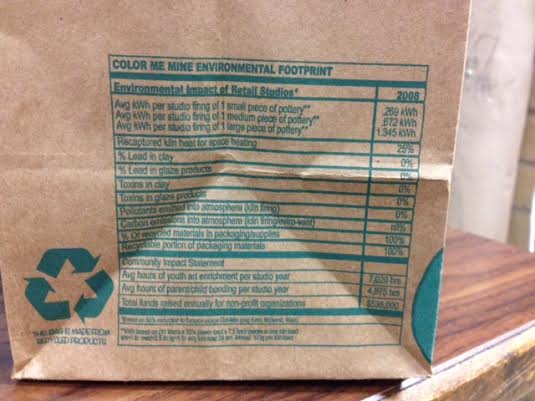I recently went to Color Me Mine, a ceramics studio in Pittsford. When a friend and I picked up our finished items, we noticed that the bags had what looked like a nutrition label on the side. When we looked closer we found that they were actually labels of the “color me mine environmental footprint.” The label listed the amount of energy used to paint and fire pottery, with .269 kWh for each small piece and 1.345 kWh for each large piece. It also listed the amount of recaptured kiln heat for space heating (25%), the toxins in their clay and glaze products (0%), and the percent of recycled material in their packaging and supplies (100%). The label also addressed the social impacts of the company. 7,020 is the average number of hours of youth art enrichment per year, 4,875 is the average number hours of parent/child bonding per year, and 536,000 dollars is the amount of money raised annually for non-profit organizations.
I liked that Color Me Mine created this label. It provided interesting information, highlighted that they were sustainability conscious, and served as a reminder that sustainability is pertinent in every location and truly holistic in nature.
An interesting Slate article explained that there is a movement to develop these types of labels so that every consumer item would list measurements such as carbon footprint, water use, and contribution to air pollution. However, this notion presents obstacles to overcome. The environmental impact of individual products is extremely complex, because it is difficult to take into account the all of the factors involved and accurately measure each one. Additionally, different products raise different environmental concerns so a standardized label might not be appropriate. While the idea is not flawless, environmental footprint labels are an interesting and engaging tool to me, and I’m eager to see how the concept progresses.
Written by Abigail Fagan, Class of 2014

